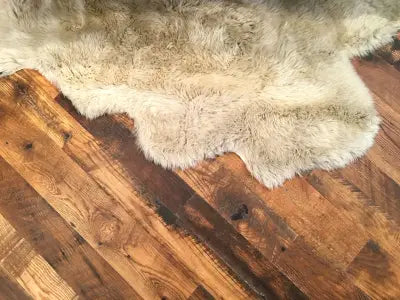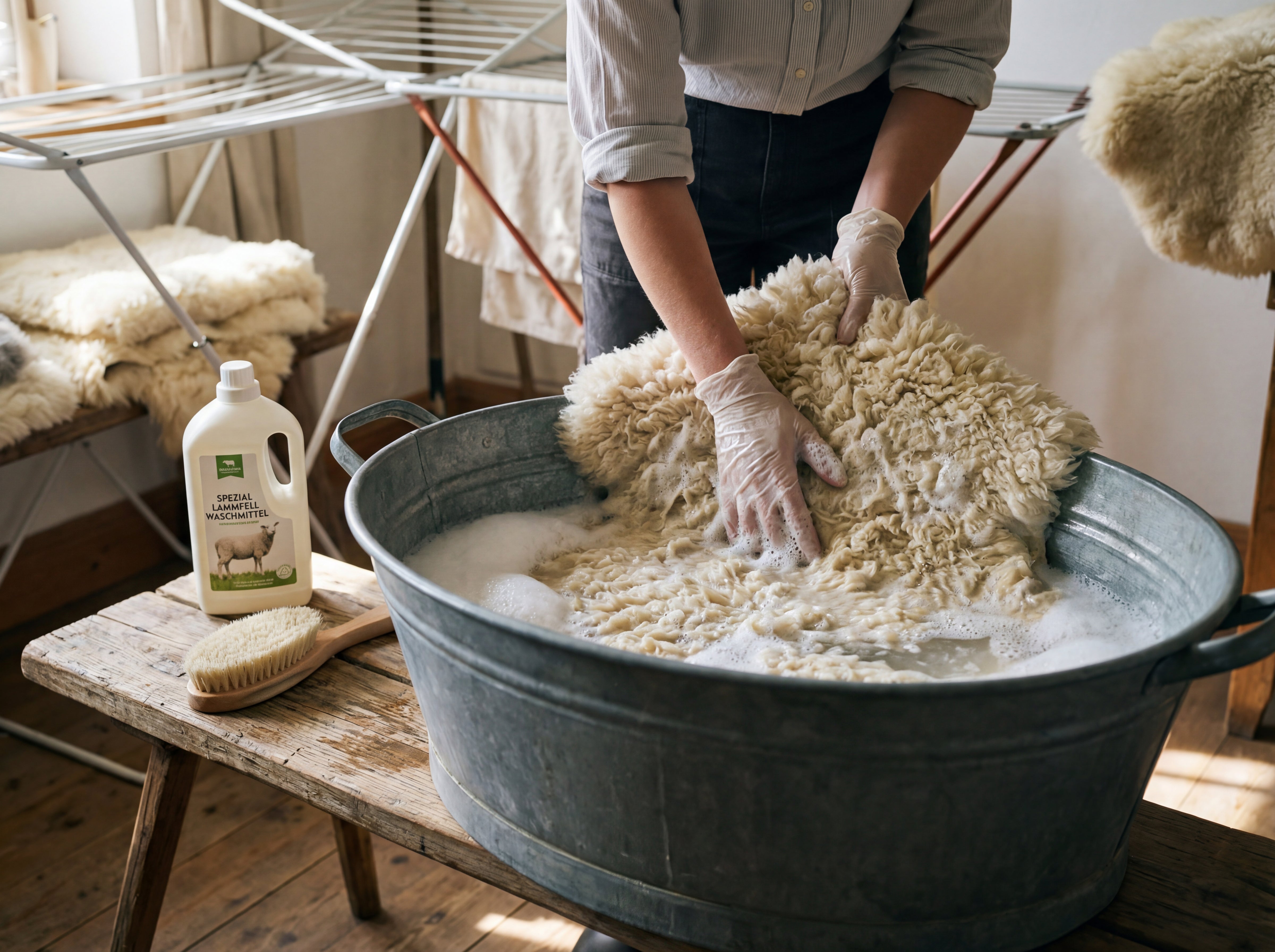Genuine sheepskin is a luxurious accessory that adds warmth and style to your home. At the same time, it's a delicate natural product that requires special care. Its soft, fluffy texture and unique properties make it a popular choice for furniture, rugs, and decorations. To ensure your sheepskin retains its beauty and functionality for years to come, proper cleaning is essential. In this article, we'll show you step-by-step how to wash your sheepskin without damaging it.
Washing a lambskin: Preparations for gentle cleaning
Thorough preparation is essential before cleaning your lamb or sheepskin. This will ensure the best results and protect the product from damage. Before you begin cleaning your hides, you should read the care label. This contains valuable information and specific instructions from the manufacturer, tailored to the individual needs of the hide.
Pay close attention to the instructions regarding recommended cleaning methods and temperatures to ensure you don't make any mistakes during cleaning. The label will also tell you whether your natural fur can be machine washed. If so, you'll find the relevant information on machine washing further down in this blog post.
Select laundry detergent
To ensure your furs retain their fluffy qualities, you should under no circumstances use a standard household detergent. These contain various chemicals and bleaching agents that damage the fur's natural oils (lanolin). Additionally, the leather can lose its softness.
For cleaning your lambskin, we recommend a mild, pH-neutral cleaning agent that is specifically suitable for delicate textiles. Which detergent is suitable for my lambskin? You can find special [products/services] in stores. Washing detergent for lamb and sheepskinsThey are pH-neutral and contain no enzymes. Alternatively, you can use a Wool detergent Use only if the product does not contain bleach, enzymes, or plasticizers. Also, the Leather care detergent This could be an option for cleaning, provided it is specifically suitable for lambskins or sheepskins.
Space requirements and temperatures

Ensure you have a suitable washing area with enough space to carry out the cleaning comfortably and without stress. Ideally, this should be a large, flat area that allows you to treat the natural fur evenly and then dry it.
Additionally, you should definitely pay attention to the water temperature before cleaning. Wash your sheepskin at a maximum of 30 degrees Celsius. Higher temperatures can cause the leather to become hard and inflexible.
If you follow these preparatory steps, the fur will retain its shape, maintain its quality, and be optimally cared for. This way, you can enjoy your stool from our range for a long time.
Gently clean your fur by hand washing.
The correct washing method is crucial to preserving the beauty and quality of your product. While using a washing machine is often not recommended, hand washing is a gentle and effective method. Follow our washing instructions for optimal cleaning results.
- Water preparation:
Fill a large basin or bathtub with water that under no circumstances exceeds the 30-degree limit.It is best to check the water temperature with a water thermometer. - Prepare the cleaning solution:
Mix a mild, pH-neutral cleaning agent with the water. Ensure the cleaning agent is completely dissolved in the water for effective cleaning. - Gentle soaking:
Carefully place the natural sheepskin in the cleaning solution and let it soak. Avoid vigorous rubbing or wringing to prevent damage to the sheepskin. Leave it in the solution for approximately 10-15 minutes to allow dirt and stains to loosen. - Gentle cleansing:
Use a soft sponge or cloth to gently rub the surface of the coat. Work in small sections and always move in the direction of the hair growth to avoid matting. - Thorough rinsing:
Empty the basin and refill it with clean, lukewarm water. Rinse the lambskin thoroughly to remove all soap residue. Repeat the rinsing process if necessary until the water runs clear and shows no traces of detergent. - Gentle expression:
Gently squeeze the water out of the material without wringing it. Roll the fur gently in a towel to absorb excess moisture. This will help speed up drying and reduce the risk of deformation.
Can I wash lambskin in the washing machine?
A sheepskin can be washed in a washing machine under certain conditions. The care label will tell you whether your product is machine washable. To ensure gentle cleaning in the machine, you should always use a delicate or wool cycle. Again, the water temperature should not exceed 30 degrees Celsius. We recommend either a pH-neutral detergent for wool or a sheepskin detergent.
After washing, you should either completely avoid spinning in the machine or use a very low spin speed at most. This way you can be sure to protect the leather of your fur.
Note: Never use fabric softener.If you decide to wash your sheepskin in a washing machine, never use fabric softener. These products contain chemicals that can dry out the leather and make it brittle. This causes the sheepskin to lose its flexibility and durability. Additionally, fabric softener leaves residue that can cause the hair to clump together and impair its fluffy texture.
Drying lambskin properly
After thoroughly washing your sheepskin, proper drying and aftercare are crucial to preserving the texture and quality of the fleece. There are two drying options, which we would like to explain in more detail.
- Air drying:
Hang the sheepskin in a well-ventilated place, ideally in a room with fresh air circulation. Avoid direct sunlight and heat sources such as radiators or space heaters, as these can dry out the sheepskin and damage the leather structure. The sheepskin should hang in its natural shape to prevent deformation. You can optionally reshape the sheepskin occasionally. - Drying flat (optional):
Alternatively, you can lay the natural fur flat on a clean, dry towel. This can be especially helpful if the fur is particularly thick or dense. Change the towel occasionally to speed up the drying process.Here too, we recommend that you regularly pull the fur into shape.
Please refrain from tumble drying the lambskin. This can damage the leather.
Care tips to prevent your lambskin from matting
Once the coat is completely dry, use a soft brush or comb to brush it out. This helps restore the coat's natural fluffy texture. Brush in the direction of the fur to avoid matting.
How can you prevent matting? Take care not to brush or pull the natural fur too vigorously, as this can cause damage. Perform regular and gentle brushing to remove loose hair and dirt particles. This helps prevent matting, keeping your product fluffy.
To maintain the freshness and softness of the lambskin, you should air it out regularly. This helps to prevent moisture and odors and keep the fleece in good condition.
These care practices will ensure that your sheepskin not only stays clean, but also in optimal condition to continue providing you with enjoyment and comfort.
How to prevent long-term damage to lambskin
To ensure your lamb or sheepskin retains its natural beauty and longevity, you should definitely avoid some common cleaning mistakes. We would be happy to inform you about the most frequent mistreatment errors.
- UV radiation:
Protect your product from direct sunlight. UV rays can dry out the leather and cause the color to fade. Therefore, store the natural fur in a shady, well-ventilated place to avoid sun damage. - Humidity and extreme temperatures:
Avoid exposing the sheepskin to extreme temperatures and humidity. High humidity can lead to mold and odors, while extreme cold can make the leather brittle. Be sure to store the sheepskin in a moderately dry room. - Inadequate care:
Don't neglect the regular washing and care of your natural product. Regular cleaning and airing are crucial to prevent matting and maintain the natural fluffiness of the fur. Without this regular care, damage can occur.
Thorough cleaning for the long-lasting beauty of your sheepskin.
Caring for and cleaning genuine lambskin requires special attention and care to preserve its unique beauty and longevity. By following the safety steps outlined below and avoiding common mistakes, you will care for your lambskin correctly. Always remember to ensure your lambskin remains in top condition. Avoid common errors and use gentle cleaning methods, whether by hand or by avoiding machine drying, to maintain the quality of the fur.



Share:
Sheepskin Washing with Shampoo – The Ultimate Guide
How do you tan sheepskin?